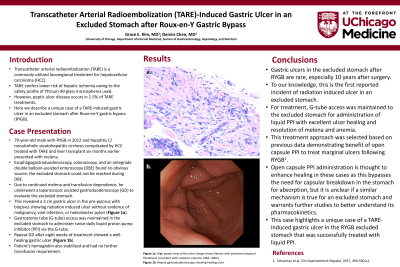Back


Poster Session E - Tuesday Afternoon
Category: Stomach
E0729 - Transcatheter Arterial Radioembolization (TARE)-Induced Gastric Ulcer in an Excluded Stomach After Roux-en-Y Gastric Bypass
Tuesday, October 25, 2022
3:00 PM – 5:00 PM ET
Location: Crown Ballroom

Has Audio
- GK
Grace E. Kim, MD
The University of Chicago Medical Center
Chicago, Illinois
Presenting Author(s)
Award: Presidential Poster Award
Grace E. Kim, MD, Beena Ahsan, MD, Dennis Chen, MD
The University of Chicago Medical Center, Chicago, IL
Introduction: Transcatheter arterial radioembolization (TARE) is a commonly utilized locoregional treatment for hepatocellular carcinoma (HCC) and confers lower risk of hepatic ischemia owing to the safety profile of Yttrium-90 glass microspheres used in TARE. However, peptic ulcer disease occurs in 1-5% of TARE treatments. Here we describe a unique case of a TARE-induced gastric ulcer in an excluded stomach after Roux-en-Y gastric bypass (RYGB).
Case Description/Methods: 70-year-old male with RYGB in 2012 and hepatitis C/nonalcoholic steatohepatitis cirrhosis complicated by HCC treated with TARE and liver transplant six months earlier was evaluated for melena. Esophagogastroduodenoscopy, colonoscopy, and an antegrade double balloon-assisted enteroscopy (DBE) found no obvious source. The excluded stomach could not be reached during DBE. Due to continued melena and transfusion dependence, he underwent a laparoscopic assisted gastroduodenoscopy (GD) to evaluate the excluded stomach. This revealed a 3 cm gastric ulcer in the pre-pylorus with biopsies showing radiation induced ulcer without evidence of malignancy, viral infection, or helicobacter pylori (Figure 1a). Gastrostomy tube (G-tube) access was maintained in the excluded stomach to administer twice daily liquid proton pump inhibitor (PPI) via the G-tube. Repeat GD after eight weeks of treatment showed a well-healing gastric ulcer (Figure 1b). Patient’s hemoglobin also stabilized and had no further transfusion requirement.
Discussion: Gastric ulcers in the excluded stomach after RYGB are rare, especially 10 years after surgery. To our knowledge, this is the first reported incident of radiation induced ulcer in an excluded stomach. For treatment, G-tube access was maintained to the excluded stomach for administration of liquid PPI with excellent ulcer healing and resolution of melena and anemia. This treatment approach was selected based on previous data demonstrating benefit of open capsule PPI to treat marginal ulcers following RYGB1. Open capsule PPI administration is thought to enhance healing in these cases as this bypasses the need for capsular breakdown in the stomach for absorption, but it is unclear if a similar mechanism is true for an excluded stomach and warrants further studies to better understand its pharmacokinetics. This case highlights a unique case of a TARE-induced gastric ulcer in the RYGB excluded stomach that was successfully treated with liquid PPI.
1Schulman et al. Clin Gastroenterol Hepatol. 2017, 494-500.e1.

Disclosures:
Grace E. Kim, MD, Beena Ahsan, MD, Dennis Chen, MD. E0729 - Transcatheter Arterial Radioembolization (TARE)-Induced Gastric Ulcer in an Excluded Stomach After Roux-en-Y Gastric Bypass, ACG 2022 Annual Scientific Meeting Abstracts. Charlotte, NC: American College of Gastroenterology.
Grace E. Kim, MD, Beena Ahsan, MD, Dennis Chen, MD
The University of Chicago Medical Center, Chicago, IL
Introduction: Transcatheter arterial radioembolization (TARE) is a commonly utilized locoregional treatment for hepatocellular carcinoma (HCC) and confers lower risk of hepatic ischemia owing to the safety profile of Yttrium-90 glass microspheres used in TARE. However, peptic ulcer disease occurs in 1-5% of TARE treatments. Here we describe a unique case of a TARE-induced gastric ulcer in an excluded stomach after Roux-en-Y gastric bypass (RYGB).
Case Description/Methods: 70-year-old male with RYGB in 2012 and hepatitis C/nonalcoholic steatohepatitis cirrhosis complicated by HCC treated with TARE and liver transplant six months earlier was evaluated for melena. Esophagogastroduodenoscopy, colonoscopy, and an antegrade double balloon-assisted enteroscopy (DBE) found no obvious source. The excluded stomach could not be reached during DBE. Due to continued melena and transfusion dependence, he underwent a laparoscopic assisted gastroduodenoscopy (GD) to evaluate the excluded stomach. This revealed a 3 cm gastric ulcer in the pre-pylorus with biopsies showing radiation induced ulcer without evidence of malignancy, viral infection, or helicobacter pylori (Figure 1a). Gastrostomy tube (G-tube) access was maintained in the excluded stomach to administer twice daily liquid proton pump inhibitor (PPI) via the G-tube. Repeat GD after eight weeks of treatment showed a well-healing gastric ulcer (Figure 1b). Patient’s hemoglobin also stabilized and had no further transfusion requirement.
Discussion: Gastric ulcers in the excluded stomach after RYGB are rare, especially 10 years after surgery. To our knowledge, this is the first reported incident of radiation induced ulcer in an excluded stomach. For treatment, G-tube access was maintained to the excluded stomach for administration of liquid PPI with excellent ulcer healing and resolution of melena and anemia. This treatment approach was selected based on previous data demonstrating benefit of open capsule PPI to treat marginal ulcers following RYGB1. Open capsule PPI administration is thought to enhance healing in these cases as this bypasses the need for capsular breakdown in the stomach for absorption, but it is unclear if a similar mechanism is true for an excluded stomach and warrants further studies to better understand its pharmacokinetics. This case highlights a unique case of a TARE-induced gastric ulcer in the RYGB excluded stomach that was successfully treated with liquid PPI.
1Schulman et al. Clin Gastroenterol Hepatol. 2017, 494-500.e1.

Figure: Figure 1a: High power view of the ulcer slough shows fibrosis with prominent atypical fibroblasts consistent with radiation enteritis (H&E, 400X)
Figure 1b: Repeat gastroduodenoscopy showing healing ulcer.
Figure 1b: Repeat gastroduodenoscopy showing healing ulcer.
Disclosures:
Grace Kim indicated no relevant financial relationships.
Beena Ahsan indicated no relevant financial relationships.
Dennis Chen indicated no relevant financial relationships.
Grace E. Kim, MD, Beena Ahsan, MD, Dennis Chen, MD. E0729 - Transcatheter Arterial Radioembolization (TARE)-Induced Gastric Ulcer in an Excluded Stomach After Roux-en-Y Gastric Bypass, ACG 2022 Annual Scientific Meeting Abstracts. Charlotte, NC: American College of Gastroenterology.


